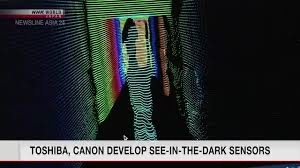
東芝:在黑暗中識別物體:
-使用激光束反射-
東芝和佳能:
宣布“一種可以在黑暗的地方產生清晰圖像的小型傳感器”。
設備使用:
從自動駕駛到機器人和安全攝像頭
它可以用於各種應用。
東芝技術:
使用激光束的反射識別黑暗中的物體。
它可以檢測300米外的物體。
A senior researcher says
the sensor can quickly detect pedestrians, as well as obstacles on the road.
Canon’s sensor
can recognize colors in a fraction of the light that traditional sensors need.It uses special pixels that react to faint light.
The firm fits more than 3 million of them into about 1 square centimeter.
NHK WORLD-JAPAN News
https://www3.nhk.or.jp/nhkworld/en/news/20220405_28/
Toshiba : Reconnaître des objets dans l’obscurité :
-Utilise la réflexion du faisceau laser-
Toshiba et Canon :
Annoncé “un petit capteur capable de générer des images claires dans des endroits sombres”.
Utilisation de l’appareil :
De la conduite autonome aux robots et caméras de sécurité
Il peut être utilisé dans diverses applications.
Technologie Toshiba :
Reconnaître des objets dans l’obscurité grâce à la réflexion d’un faisceau laser.
Il peut détecter des objets à 300 mètres.
Toshiba: Objekte im Dunkeln erkennen:
-Verwendet Laserstrahlreflexion-
Toshiba und Canon:
Angekündigt “ein kleiner Sensor, der an dunklen Orten klare Bilder erzeugen kann”.
Gerätenutzung:
Vom autonomen Fahren bis hin zu Robotern und Sicherheitskameras
Es kann in verschiedenen Anwendungen verwendet werden.
Toshiba-Technologie:
Erkennen Sie Objekte im Dunkeln anhand der Reflexion eines Laserstrahls.
Es kann Objekte in einer Entfernung von 300 Metern erkennen.
Canon develops SPAD sensor with world-highest 3.2-megapixel count, innovates with low-light imaging camera that realizes high color reproduction even in dark environments
Canon Global TOKYO,
December 15, 2021Canon Inc. announced today that the company, thanks to a proprietary pixel architecture that efficiently captures and greatly multiplies light,
has successfully developed an ultra-small 13.2 mm x 9.9 mm SPAD sensor
capable of capturing the world’s highest1 resolution of 3.2-megapixel images—a higher resolution than Full HD (approximately 2.07 megapixels), even in low-light environments.
Manufacture of the new sensor
will commence in the second half of 2022.In addition,
a research paper detailing the company’s findings has been selected for the Late News Papers2 ,an extremely competitive publication of the IEDM3 conference, opened on December 11, 2021.